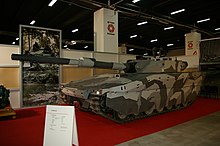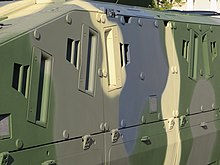AMAP-ADS
The ADS (Active Defence System), formerly known as AMAP-ADS, is a hard-kill active protection system (APS), developed by the German company ADS Gesellschaft für aktive Schutzsysteme, a subsidiary of Rheinmetall and IBD Deisenroth Engineering,[1] as part of their Advanced Modular Armor Protection concept. The system was also known under the name AAC (Active Armor Concept) in Sweden and as Shark in France.
In 2019, a new version of the ADS known as the Hybrid Protection Module was revealed, which integrates the components of the active protection system into passive spaced armor. It is being marketed internationally under the name Strike Shield.
Due to its modular design, the ADS can be adapted to a broad range of vehicles. In particular, it is capable of protecting light vehicles against large caliber weapons which the vehicles' light armor wouldn't stop.
Design[edit]

The Active Defense System has a modular design that can be adapted to almost every vehicle; it weighs 140 kg for light vehicles and up to 500 kg for heavy vehicles. The main elements are the sensor-countermeasure modules arranged all around the vehicle. A processor determines the type and the trajectory of the approaching target. Subsequently, a countermeasure module close to the calculated impact point is activated. This countermeasure destroys or disrupts the approaching threat so that it cannot penetrate the vehicle.[2]
The arrangement of sensors and countermeasures provides a hemispherical protection. The overlapping sectors of the sensor-countermeasure modules enable the system to defeat multi-attacks. Due to the short reaction time of approximately 560 microseconds, threats can be eliminated at ranges of approximately 10 m, not depending on the speed of the threat.[3] AMAP-ADS is one of the fastest active protection systems, faster than Quick Kill, Iron Fist or Trophy.[3] Since the countermeasures create a non-fragmenting stream of material, collateral damage to nearby troops or civilians is minimized. These are important aspects in urban environments. In comparison to other hard-kill systems, there are no moving parts. This makes ADS light and reduces power requirements. Therefore, it can be installed on lightweight vehicles.
The system is not intended to completely substitute for passive base armor. Larger caliber projectiles will only be fragmented and not entirely deflected. Therefore, a minimum of passive armor is still required to absorb the residual energy of the fragments.
Successful demonstrations[edit]
AMAP-ADS has been tested on several platforms. As part of the Active Armor Concept it was installed on the SEP designed by BAE Systems Hägglunds. On 17 April 2008 it was tested in Sweden under urban combat conditions. Threat rejection and multi-hit capability were proven, when 7.62 mm rounds and RPG-7s were fired from a short distance of some 50 m, a range typical for urban missions. In that test the RPG-7 projectiles were destroyed. The system also detected a 7.62 mm round but rejected it as a threat.[4]
US testings[edit]
A Textron ASV vehicle has been modified and equipped with the AMAP-ADS hardkill-system. Then it was tested for 6 weeks extensively at Redstone Arsenal in Huntsville, Alabama.[5] These tests were overseen by the Office of the Secretary of Defense. Different types of RPGs and ATGMs were launched at various spots like the sides or the roof from close range (15 metres (49 ft), including multi-hit attacks, in which multiple threats were used in a short period of time.[5] AMAP-ADS met or even exceeded all US requirements during the tests.[5] The operationability in hot climates was also proven.
ADS-Gen3[edit]
Continuous improvments to the ADS lead to the third generation of the system being revealed in 2017 under the name ADS-Gen3, which offers several key improvements over the earlier version. Like the earlier versions, it utilizes multiple effectors and sensors distributed over the vehicle's surface. The redudancy of sensors and effectors ensures that every area is protected against at least three attacks.[6]
The ADS-Gen3 uses newer radar sensors operating at a lower output; this reduces the radar's range to only 30 metres (98 ft) and results in the ADS-Gen3 having a significantly smaller EM signature than other hardkill APS.[6] The radar sensors operate in the 20 to 30 GHz waveband and have a power output of only 1 Watt.[7] This results in the ADS-Gen3 being only detectable at ranges up to 350–400 metres (1,150–1,310 ft) by enemy ESM sensors.[7] The shorter range of the radars also means that a higher resolution can be achieved, allowing the system to more accurately determine the type of the incoming rounds and react to staggered attacks from weapon systems such as the RPG-30. The lower EM signature reduces the probability to affect electronics of nearby allied vehicles.[6]
The short minimum defeat distance of the ADS-Gen3 allows intercepting projectiles launched as close as 10 metres (33 ft) from the protected vehicle.[6] In case of the ADS-Gen3, the interception is claimed to be so accurate that the warhead of an incoming projectile can be defeated without setting off the fuze, resulting in less danger to nearby civilians, infantry and vehicles.[6]
The ADS-Gen3 is the first hardkill APS certified to the highest safety standard IEC 61508 in 2017[8] and was certified for ISO 61508 SIL 3 in 2018.
Strike Shield[edit]

StrikeShield APS on Lynx IFV of the Hungarian Army At IDEX 2019, Rheinmetall presented its Hybrid Protection Module based on the ADS, which houses the components of the active protection system between two layers of spaced armor. In the original version, the outer and the inner armor plate offered ballistic protection according to STANAG 4569 Level 2 individually or ballistic protection up to STANAG 4569 Level 5 when combined.[9] The Hybrid Protection Module can be mounted on existing interface for installing passive add-on armor and requires about 150 millimetres (5.9 in) of space. Integrating the ADS's components inside the spaced armor allows saving up to 50% of the system's weight, but as the weight of the passive armor slightly increases, the overall weight saving is only 35%.[9]
The Hybrid Protection Module received the brand name Strike Shield in 2019 and was offered in cooperation with the US company Unified Business Technologies in the US Army's APS program for the Stryker.[10] Strike Shield was selected as hardkill system for the KF41 Lynx of the Hungarian Army in 2021.[11]

In 2022, Rheinmetall presented its KF51 Panther main battle tank fitted with the Strike Shield APS along the hull to protect against ATGMs, RPGs and KE rounds such as large-caliber APFSDS ammunition.[12] At DSEI 2023, the Strike Shield's passive armor was advertised with protection ranging from STANAG 4569 Level 3 to 6.
The ADS-Gen3 and Strike Shield can use two different types of countermeasures: a lighter effector to defeat ATGMs and RPGs and a heavier effector that generates much more energy to defeat APFSDS rounds.[13] Tests with the Strike Shield APS were carried out in cooperation with the Bundeswehr to verify its anti-KE performance.[12] Two types of APFSDS ammunition were used: the 125 mm 3BM42 APFSDS and a Western 120 mm APFSDS fired from just 200 metres (660 ft) distance to simulate future threats.[12] In photographs provided by Rheinmetall, the APFSDS projectile is tilted or broken in several pieces after interception by the ADS/Strike Shield; while the company has not revealed performance figures, according to an unspecific source the penetration can be reduced by up to 75%.[12]
Like the earlier ADS versions, Strike Shield uses a Central Information Management (CIM) system to process the data from the sensors, classify the threat and engage it. On MBTs, two CIMs can be installed: one for the hull and one for the turret, if the Strike Shield APS is installed on both the turret and hull. Depending on the difficulty of the threat, more than one countermeasure can be used to intercept the threat.[12]
Applications[edit]
Prototypes of the ADS have been tested on several vehicles including the Marder,[14] the SEP, the Combat Vehicle 90, the Patria AMV and the Iveco LMV.
In 2011, the series production of (AMAP-)ADS started for an Asian user of the Leopard 2A4[6] while a number of European armies are considering buying it.[1] Over 80 systems were delivered for use on the Leopard 2 tank.[7] While Rheinmetall did not want to disclose the customer, the system was reportedly fitted to Leopard 2 tanks of Singapore.[15][16]
The Strike Shield APS has been series produced for the KF41 Lynx. It has been showcased on the KF51 Panther and the GTK Boxer.
References[edit]
- Strategie & Technik International Edition II/2007, Active Stand-Off Protection Systems, p.35-43
- ^ a b "Rheinmetall takes up a majority share in ADS GmbH; Breakthrough serial order for innovative ADS protection system". Archived from the original on 2012-03-15. Retrieved 4 February 2011.
- ^ "AMAP ADS Active Defence System part demo". YouTube, Rheinmetall & IBD Deisenroth Engineering. July 7, 2012. Archived from the original on 2021-12-21. Retrieved 1 August 2013.
- ^ a b Dieter Haug and Hans Joachim Wagner. "Strategie u. Technik, int. Edition, Autumn, 2009" (PDF). Archived from the original (PDF) on 2011-10-08. Retrieved 18 February 2011.(Authorization Required)
- ^ "Rheinmetall tests new Active Defense System under live fire". February 2012.
- ^ a b c "IBD Live February 2011" (PDF). Archived from the original (PDF) on 19 July 2011. Retrieved 18 February 2011.
- ^ a b c d e f Meixner, Ronald M. (November 2017). "Die Zukunft der abstandsaktiven Schutzsysteme". Wehrtechnischer Report (in German). 4/2017: 57–58.
- ^ a b c "Rheinmetall Showcases Hybrid Protection Module at IDEX 2019". Defence Turkey. Retrieved 21 May 2024.
- ^ "ADS defines the next generation of APS". ads-protection.org. Retrieved 21 May 2024.
- ^ a b Valpolini, Paolo. "IDEX 2019: Rheinmetall introduces hybrid protection modules for vehicles". EDR Online - European Defence Review. Retrieved 21 May 2024.
- ^ Heiming, Gerhard. "Aktives Schutzsystem StrikeShield für U.S. Army". Soldat und Technik (in German). Retrieved 21 May 2024.
- ^ Gerhard Heiming; Kristóf Nagy. "Ungarn: Lynx Schützenpanzer erhalten aktives Schutzsystem StrikeShield". Soldat und Technik (in German). Retrieved 21 May 2024.
- ^ a b c d e Valpolini, Paolo. "IAV Conference: Rheinmetall details its hybrid armour solution". EDR Online - European Defence Review. Retrieved 21 May 2024.
- ^ Valpolini, Paolo. "Increasing survivability while lowering the protection-induced mass". EDR Online - European Defence Review. Retrieved 21 May 2024.
- ^ "IBD's News on St. Barbara Symposium 2008" (PDF). Archived from the original (PDF) on 18 July 2011. Retrieved 18 February 2011.
- ^ Yeo, Mike (2021-10-18). "TERMINAL DEFENCE". ADBR. Retrieved 2023-09-24.
- ^ Jr, Sydney J. Freedberg (2018-01-22). "Rheinmetall Rolls Out 'Safer' Active Protection For Tanks". Breaking Defense. Retrieved 2023-09-24.
External links[edit]
- Manufacturer links (Authorization Required)
- Webpage of Manufacturer[permanent dead link]
- AMAP-ADS Simulation (Video)
- Video of a live demonstration of AMAP-ADS[permanent dead link] on the Eurosatory 2010.
- SEP DEMO
- Active Defense System (ADS)
- Active Protection Systems Are Maturing
- ADS Gmbh website
